
Ballymoney is a town and civil parish in County Antrim, Northern Ireland. It is within the Causeway Coast and Glens Borough Council area. The civil parish of Ballymoney is situated in the historic baronies of Dunluce Upper and Kilconway in County Antrim, as well as the barony of North East Liberties of Coleraine in County Londonderry. It had a population of 11,048 people at the 2021 Census.
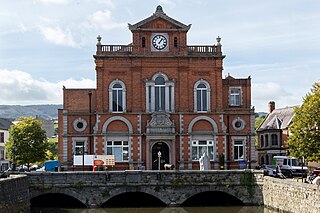
Newry Town Hall is a municipal structure in Bank Parade in Newry, Northern Ireland. It was built on a specially-constructed bridge across the Newry River, which forms part of the historic border between County Armagh and County Down. The town hall, which was the headquarters of Newry Urban District Council, is a Grade B1 listed building.

Market House is a municipal building in Conway Square, Newtownards, County Down, Northern Ireland. It is a Grade B+ listed building.

County Hall, formerly known as Dún Laoghaire Town Hall, and before that, Kingstown Town Hall, is a municipal facility in Marine Road, Dún Laoghaire in the county of Dún Laoghaire–Rathdown, Ireland.
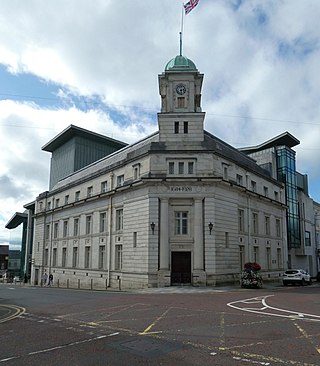
Ballymena Town Hall is a municipal structure in Bridge Street in Ballymena, County Antrim, Northern Ireland. The town hall, which is the headquarters of Mid and East Antrim Borough Council, is a Grade B1 listed building.

Carrickfergus Town Hall is a municipal structure in Joymount in Carrickfergus, County Antrim, Northern Ireland. The town hall, which was the headquarters of Carrickfergus Borough Council, is a Grade B+ listed building.
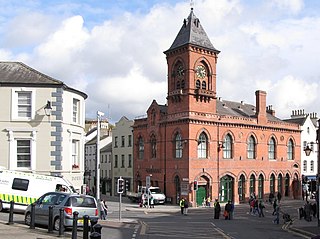
The Down Arts Centre, formerly Downpatrick Town Hall and also Downpatrick Assembly Rooms, is a municipal structure in Irish Street in Downpatrick, County Down, Northern Ireland. The structure, which was the meeting place of Down Urban District Council, is a Grade B1 listed building.
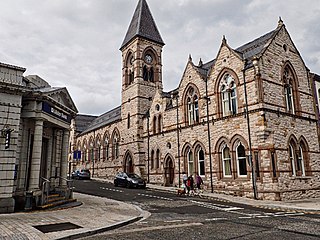
Larne Town Hall is a municipal structure in Upper Cross Street in Larne, County Antrim, Northern Ireland. The structure, which was the meeting place of Larne Borough Council, is a Grade B+ listed building.

The Queen's Hall, formerly Hexham Town Hall, is a municipal structure in Beaumont Street, Hexham, Northumberland, England. The structure, which was the headquarters of Hexham Urban District Council and is now an arts centre, is a Grade II listed building.

Ballyclare Town Hall is a municipal structure in The Square, Ballyclare, County Antrim, Northern Ireland. The structure, which is primarily used as an events venue, is a Grade B2 listed building.

Bampton Town Hall is a municipal building in the Market Square in Bampton, Oxfordshire, England. The building, which is primarily used as an arts centre, is a Grade II listed building.
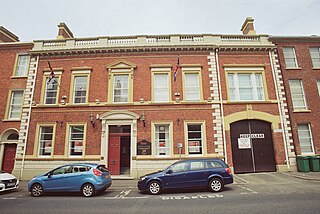
The Old Town Hall is a municipal structure in Castle Street, Lisburn, County Antrim, Northern Ireland. The structure, which is used as a constituency office by the Democratic Unionist Party, is a Grade B2 listed building.
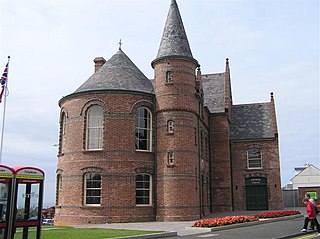
Portrush Town Hall is a municipal structure in Mark Street, Portrush, County Antrim, Northern Ireland. The structure, which is used as an events venue, is a Grade B+ listed building.
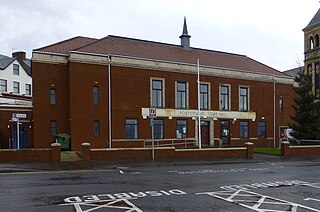
Portstewart Town Hall is a municipal structure in The Crescent, Portstewart, County Londonderry, Northern Ireland. The structure, which has been closed to the public since December 2019, is a Grade B2 listed building.
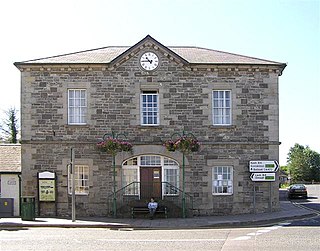
Ederney Town Hall, also styled as Ederney Townhall, is a municipal structure in Market Street, Ederney, County Fermanagh, Northern Ireland. The structure, which is used as a community events venue, is a Grade B1 listed building.
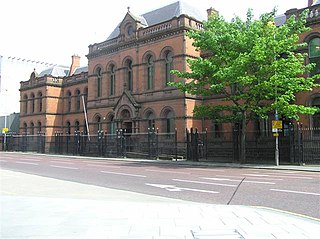
The Old Town Hall is a municipal structure in Victoria Street, Belfast, Northern Ireland. The structure, which has most recently been used as courthouse, is a Grade B1 listed building.

Sanquhar Tolbooth is a municipal building in the High Street in Sanquhar, Dumfries and Galloway, Scotland. The structure, which accommodates a local history museum, is a Category A listed building.

Wick Sheriff Court is a judicial structure in Bridge Street, Wick, Caithness, Scotland. The structure, which remains in use as a courthouse, is a Category B listed building.
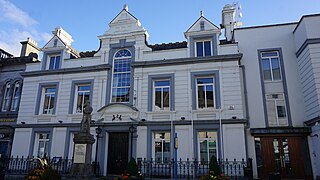
Clonmel Town Hall is a municipal building in Parnell Street, Clonmel, County Tipperary, Ireland. The building accommodated the offices of Clonmel Borough Council until 2014.

Linenhall Arts Centre, formerly Castlebar Town Hall, is a municipal building in Linenhall Street, Castlebar, County Mayo, Ireland. The building, which was used as the local town hall through much of the first half of the 20th century, is now used as an arts centre.






















